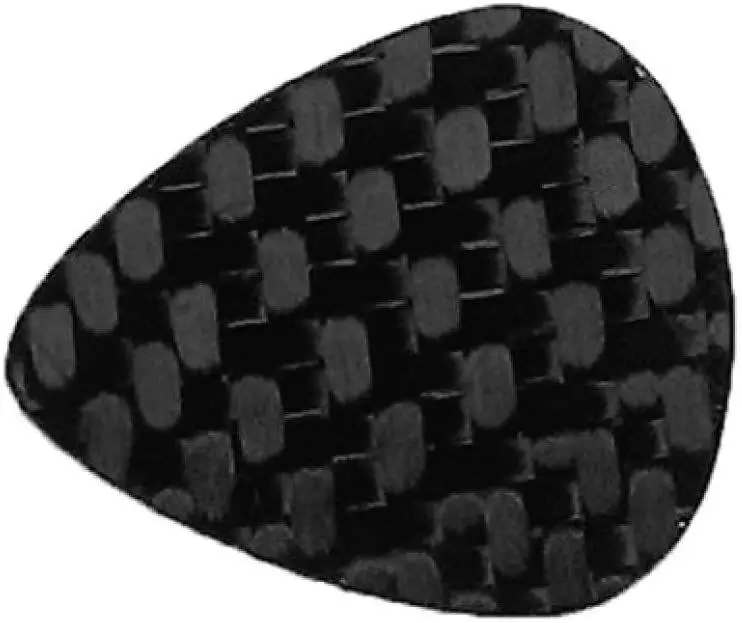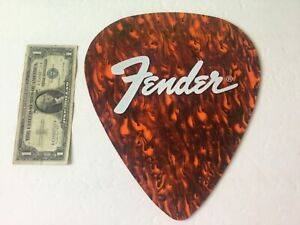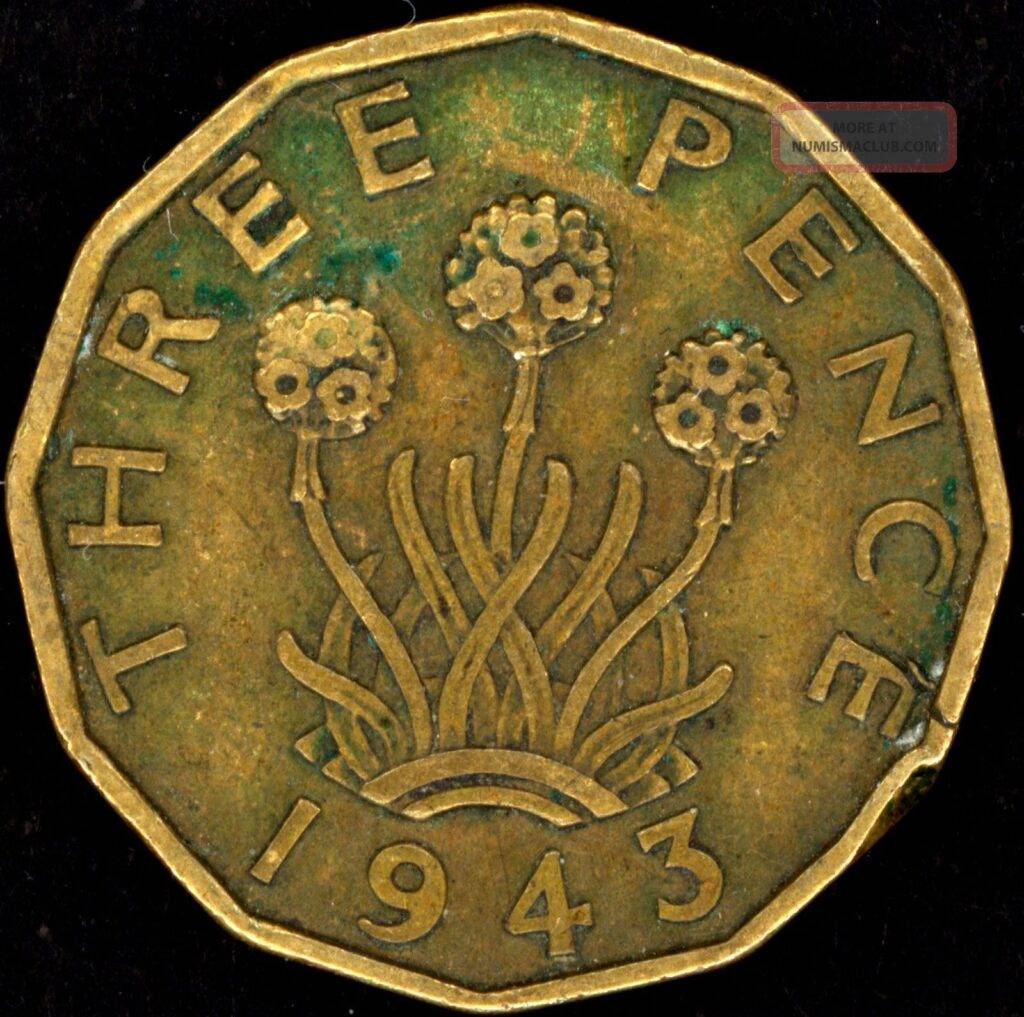A few words discussing our pick sizes/dimensions Form Factors from thicknesses to width:

Picks vary wildly in thickness, for obvious and less obvious reasons. Pick sizes/dimensions Form Factors can range from over 12mm (Yes, just imagine, here are some)…
…down to under .4 mm perhaps, such as my carbon fiber pick at .20mm seen here:

Stiffness notwithstanding (the carbon fiber pick flexes, yet has a firmness that might surprise you), there are other reasons for differences in thickness.
One of the most important reasons for varying a pick’s size/dimensions through-thickness is the improved grip (there is an exception to the rule here) and along with that, comfort.
On the other hand, in Pick Sizes/Dimensions Form Factors, flexibility is the biggest element to Pick sizes/dimensions as far as thicknesses. A thin pick will bend and “give” as a player strikes firmly, helping them keep ahold of the pick.
Thickness not only varies but how thick a pick is won’t consistently affect flex across different materials. Some materials like the above Carbon fiber pick are a Little flexible but still pretty stiff and very hard. On the other hand, a pick like the Holy Grail I cover in a review is very flappy and flexible yet a little bit thicker in comparison.
A pick made of brittle material it can be less durable.
Let’s say you have arthritis, as I do, the thicker picks, especially the extremely thick picks, might be easier and less painful for long playing sessions. But accuracy might take a back seat with a thick pick. It does vary with the tip/point shape too. There are pros that can shred like crazy with a fine tipped 7mm thick monster pick. But then there is YOU, you might not do so as easily. This is the reason there is such a huge variety of picks out there!
Pick Sizes/Dimensions Form Factors are named descriptively based upon a range in millimeters:
- Ultra-thin < .40mm
- Thin > .40mm < .60mm
- Medium > .60mm < 1.0mm
- Heavy > 1.0 mm < 1.5mm
- Extra Heavy > 1.5mm < 3.00mm
- Very Heavy > 3.00 mm <?
Thickness also has a corresponding relationship with the width and length of a given pick. Wider picks are often, but not always, thicker. As thickness increases, the width will have to increase as there are very few – if not no – 3” wide picks that are .4mm thick (YET!). Of course, decorative art picks notwithstanding:

With Pick Sizes/Dimensions Form Factors an ultra-thick pick, the material thickness can even be varied from back to the tip, or, even perhaps better, from the middle sloping to the back and tip both. Such an angled pick can help with grip and comfort, but it will cost you.
For extremely thick picks dimensions out of fine plastics, expect to pay well over 30 US Dollars, and even 100, 200 Dollars or more:
Pick materials can be very expensive, combine that with the pick sizes/dimensions, and you can see prices skyrocketing. Here is an example.
I would say, try a very thick pick that has an angled wedge to it, on both the width and thickness sides, to correspond with your thumb and finger which touch together on a similar angle. (Make an “OK” sign with your fingers to see what I am talking about.)

That hand gesture is offensive, please ignore that for the moment and just look at the index and thumb fingers. See how they curve into a circle? Natural grip of a pick’s dimension and shape in our hand Some picks are curved in the aforementioned fashion.
In Pick Sizes/Dimensions, Form Factors Thickness also affects tone, lending to firmer responses or warmer tones with various natures, and attack and decay are more or less abrupt, as corresponding to the string sliding off one.
Also, an important consideration is whether the player is a novice or intermediate, or pro. This is because picks will tend to fly out of fingers and hands but the problem is improved with the amount of practice one gives to playing. (More on this with my descriptions and ratings of pick grip items and materials elsewhere on this site.)
Nevertheless, with your thinner picks, strumming will tend to be easier, such as on a steel-string acoustic flat-top guitar, whereas rapid alternate picking on a 2.6mm pick is easier. This relates to, how, when alternate strumming up and down, the pick is not pushed as much in a twisting motion, out of place. It doesn’t happen because the tip gives way, flexing and reducing the deflection caused by the curve and edge of the tip.
Also, consider that you can hold a pick perfectly flat orthogonally to the strings, or rather you can “slice” at the strings. Doing that latter will make thicker picks move out of place without some factor helping grip. Hence the reason I discuss Pick Sizes/Dimensions Form Factors here.
Thinner picks flex when made with less hard materials, and that flex helps with grip in strumming and hard hand movements. Even great guitarists like Eddie Van Halen liked some flex in his pick:

As a general rule, you will want to try different pick sizes/dimensions with varied thicknesses along with different materials. Keep in mind that what material is used to make a pick might require a minimum thickness or it could be too fragile, such as a natural seashell or wooden plectra. You would easily break a .4 mm pick of those materials. (Also, some materials, like shells, only exist up to a certain thickness in nature, so conversely, that is a limitation also.)
Pick dimensions don’t only involve curving a pick on both sides so the tip is still narrow on a huge pick, they also are edge-beveled (or rounded), so that will be next to talk about: There are V-Bevels, Chamfered bevels, Speed Bevels (offset edges to help some alternate shredders out there), and Squared non-bevels, often in crude devices.
To get an actual bevel, a pick has to be thick enough for the bevel to even be made. If you tried to bevel a thin pick, you might end up with a knife.
Now another thing, the thickness part of Pick Sizes/Dimensions Form Factors isn’t always the sole dictator of flex, because the modulus of flex of some materials such as carbon or steel, is much stiffer. So thickness goes hand in hand with material and shape:
Carbon Fiber is, as the name implies, a compressed fiber with adhesives. It’s not just used in picks, but in jets, weapons, and personal protection, it’s even present in cars, and get this: It’s used in Flat Top Acoustics!
In our reviews here, we will provide dimensional data including thickness to help you with your shopping and understanding. A Nylon Pick of .55 thickness will flop and bend, whereas nylon of 1.1mm will be pretty stiff with less of a touch of flex. However, a -.4mm Carbon fiber pick will only have a slight flex at that thickness.
Before you buy, read this site and its continuing reviews to help you know what you are getting. But as always, remember that your mileage will vary.
More reviews are coming, and I plan on submitting new ones every few weeks for the foreseeable future. See my Blog.
On a pick’s Tip Size and Shape:
You might not realize this as being a HUGE factor, but pick-tip shape can be quite important to your playing. A more experienced speed shredder will very often go for a very sharp tip. This is because they have fantastic control and accuracy. They grasp more of the length of the pick in their hand and are consistent with hand movements. This is great if you have a light touch and can handle very small-precise movements.
On the other hand, if one likes a larger pick but does strumming, the inflexibility of a thicker, bigger pick may require a blunter tip. They might not compare for accuracy, but a rounded tip might be fantastic for slamming chords. So a pick’s dimensions play a huge part in how it can be used and on what instrument.
For example, I will do a review of a stone pick I have in the coming reviews and it has a well-rounded tip great for strumming.
Be open-minded and try a variety of pick sizes/dimensions your experience and strength (your hands and arms)matter. A starter pick should be a semi-rounded tip. Some things you might not even find, like a very sharp tip on a very flexible pick, this is simply not logical for a pick.
Even so, you can reshape your own picks. Some 200 grit and then less than 400 grit and some elbow grease and you might have a ringer!
If you are starting out, you will likely prefer a semi-round tip on a slightly flexible pick, but as you grow, that will likely change, let your picks grow with you. It may take some time, don’t give up. There is a meme with the dog’s nose: this dog is trained to smell out those not practicing enough (get with it, dude!)
I am addressing this with experienced players as well. I can’t lecture a better guitarist than myself. If your mind is set in stone (see what I did there?) then you might prejudice yourself from discovering something new and terrific. So I’m just sayin’…
Hard or thick pick strummers will lean towards sharper tips though there are exceptions such as Brian May with his coin. His coin does have a well-defined edge, but it isn’t V-Shaped. He is a shredder with a round coin. You can still get these coins if you search for them. But keep in mind that the pick dimensions on this is very small.

A beginner won’t feel the same with a certain tip as a 5-year touring veteran. The more you practice and become precise, the more your picks will change, don’t let them hold you down.
Now, ok, this isn’t for beginners, but: About bevels… Many, picks aren’t beveled and that is partly because of how thin they are. Their thin dimensions prevent the wide-flat edges from being formed, however:
For bevels, yet, there are flattened edges, flat on the right or left-handed. These are called bevels (on more expensive picks), and there are also V-edged bevels. And there are speed bevels as I’ve mentioned:

I don’t have a lot of insight on this because it is so highly subjective to the user.
Please just be aware that they exist on many picks and don’t forget to specify what you want. Some bevels are called “speed bevels” but we aren’t one to believe that they increase speed, since they add to the distance of the pick to the string, lengthening the time until it is struck. Still, there are pros that swear by them and others that revile them. Look at how that bevel is larger on one side, making a right-hand bevel in the photo.
It is a thing, choose wisely over your career, at least try them and compare them with similar picks without the bevel.
Ok, on the other side of things, many picks are unfinished or only partly shaped and buffed, you might want a sanding block or emery paper, and try your own muscle grease on some things! Some have flashing/Spill-over from the pressing, you can sand it off. This is particularly true with nylon picks of late.
What do you have to say? What is your opinion of the different bevel types?
Now, we can go back to the Form Factors Intro Page and read about Actual Form Factors, the actual shapes of guitar picks

Drop a comment!